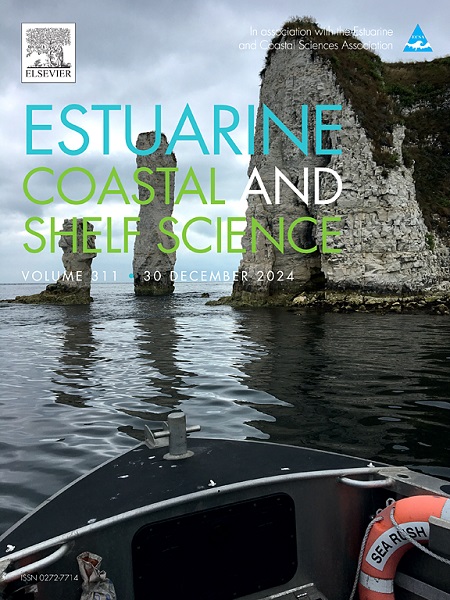Long-term assessment of forcing conditions affecting the hydrodynamic structure of a stratified sea strait
IF 2.6
3区 地球科学
Q1 MARINE & FRESHWATER BIOLOGY
引用次数: 0
Abstract
Sea straits are waterways characterized by stratified flow, in which the upper layer flow is driven by barotropic forcing while the lower layer flow is driven by the density difference between adjacent basins. The flow structures of a strait and the water bodies they are connected to are highly dependent on meteorological and hydrological conditions and change significantly as a result of extreme events in these conditions. The present study examines long-term variability in extreme meteorological and hydrological forcing conditions that control the hydrodynamic behavior of a sea strait, the Bosphorus, using 80-year (1931–2010) discharge data of the Danube River and 42-year (1979–2020) meteorological data. In addition to long-term trend analysis, extreme value analysis (EVA) was applied to both the maximum and minimum values of both parameters. In the Danube River discharges, trend directions have changed in successive 20-year periods from 1931 to 2010, but most of the trends are not significant except for the last 20 years of records. Extreme value analysis results indicate that both extreme maximum and minimum discharges are about 10 % greater in recent years (1971–2010) compared with earlier years (1931–1970). The wind conditions in the strait are less variable compared with freshwater discharges. However, the storm analysis indicates the occurrence of more energetic and short-lived storms in the Bosphorus in recent years with greater variability. The variation in extreme pressure differences is more notable, especially in the recent 20-year period. A 37 % decrease in minimum pressure difference, which means higher pressures at the southern entrance of the Bosphorus, indicates that extreme northward current events in the Bosphorus have decreased in recent years. This, combined with the increasing extreme river discharges, indicates a higher dominance of the brackish Black Sea water both in the hydrodynamics of the strait and the Sea of Marmara-northern Aegean Sea system in the future.
影响分层海峡水动力结构的强迫条件的长期评估
海峡是一种以分层流动为特征的水道,上层流动受正压强迫驱动,下层流动受邻近盆地间密度差驱动。海峡的水流结构及其所连接的水体高度依赖于气象和水文条件,并因这些条件下的极端事件而发生显著变化。本研究利用多瑙河80年(1931-2010)流量数据和42年(1979-2020)气象数据,考察了控制博斯普鲁斯海峡水动力行为的极端气象和水文强迫条件的长期变化。除长期趋势分析外,对两个参数的最大值和最小值均进行了极值分析(EVA)。多瑙河流量在1931 ~ 2010年连续20年的变化趋势中,除近20年记录外,大部分变化趋势不显著。极值分析结果表明,近年来(1971-2010年)的极端最大和最小流量都比早期(1931-1970年)增加了约10%。与淡水排放相比,海峡内的风况变化较小。然而,风暴分析表明,近年来博斯普鲁斯海峡出现了更多的能量和短暂的风暴,变化更大。极端气压差的变化更为显著,特别是近20年。最小压差下降37%,这意味着博斯普鲁斯海峡南口压力升高,表明近年来博斯普鲁斯海峡极端向北流事件减少。这与日益增加的极端河流流量相结合,表明在未来的海峡和马尔马拉海-爱琴海北部系统的水动力中,咸淡黑海水将占据更高的主导地位。
本文章由计算机程序翻译,如有差异,请以英文原文为准。
求助全文
约1分钟内获得全文
求助全文
来源期刊
CiteScore
5.60
自引率
7.10%
发文量
374
审稿时长
9 months
期刊介绍:
Estuarine, Coastal and Shelf Science is an international multidisciplinary journal devoted to the analysis of saline water phenomena ranging from the outer edge of the continental shelf to the upper limits of the tidal zone. The journal provides a unique forum, unifying the multidisciplinary approaches to the study of the oceanography of estuaries, coastal zones, and continental shelf seas. It features original research papers, review papers and short communications treating such disciplines as zoology, botany, geology, sedimentology, physical oceanography.

 求助内容:
求助内容: 应助结果提醒方式:
应助结果提醒方式:


